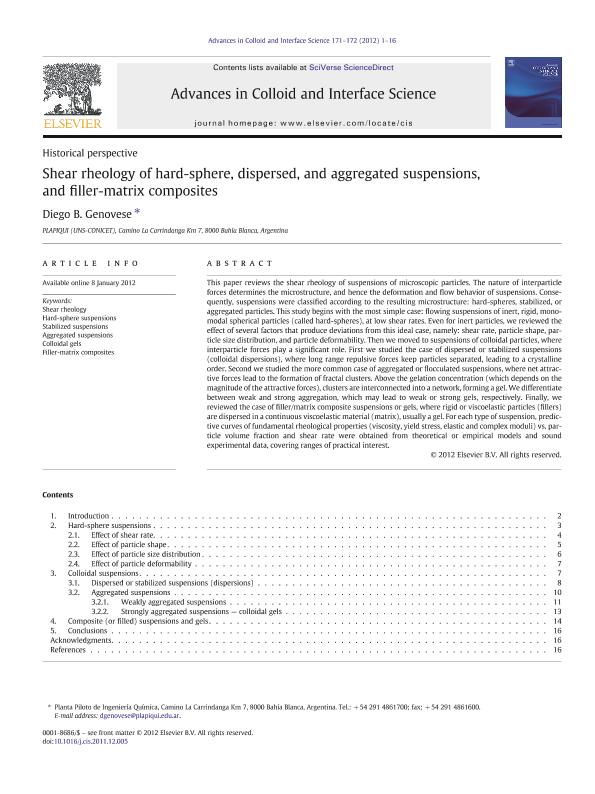Mostrar el registro sencillo del ítem
dc.contributor.author
Genovese, Diego Bautista

dc.date.available
2018-08-03T21:30:04Z
dc.date.issued
2012-03
dc.identifier.citation
Genovese, Diego Bautista; Shear rheology of hard-sphere, dispersed, and aggregated suspensions, and filler-matrix composites; Elsevier Science; Advances In Colloid And Interface Science.; 171-172; 3-2012; 1-16
dc.identifier.issn
0001-8686
dc.identifier.uri
http://hdl.handle.net/11336/54201
dc.description.abstract
This paper reviews the shear rheology of suspensions of microscopic particles. The nature of interparticle forces determines the microstructure, and hence the deformation and flow behavior of suspensions. Consequently, suspensions were classified according to the resulting microstructure: hard-spheres, stabilized, or aggregated particles. This study begins with the most simple case: flowing suspensions of inert, rigid, monomodal spherical particles (called hard-spheres), at low shear rates. Even for inert particles, we reviewed the effect of several factors that produce deviations from this ideal case, namely: shear rate, particle shape, particle size distribution, and particle deformability. Then we moved to suspensions of colloidal particles, where interparticle forces play a significant role. First we studied the case of dispersed or stabilized suspensions (colloidal dispersions), where long range repulsive forces keep particles separated, leading to a crystalline order. Second we studied the more common case of aggregated or flocculated suspensions, where net attractive forces lead to the formation of fractal clusters. Above the gelation concentration (which depends on the magnitude of the attractive forces), clusters are interconnected into a network, forming a gel. We differentiate between weak and strong aggregation, which may lead to weak or strong gels, respectively. Finally, we reviewed the case of filler/matrix composite suspensions or gels, where rigid or viscoelastic particles (fillers) are dispersed in a continuous viscoelastic material (matrix), usually a gel. For each type of suspension, predictive curves of fundamental rheological properties (viscosity, yield stress, elastic and complex moduli) vs. particle volume fraction and shear rate were obtained from theoretical or empirical models and sound experimental data, covering ranges of practical interest.
dc.format
application/pdf
dc.language.iso
eng
dc.publisher
Elsevier Science

dc.rights
info:eu-repo/semantics/openAccess
dc.rights.uri
https://creativecommons.org/licenses/by-nc-nd/2.5/ar/
dc.subject
Aggregated Suspensions
dc.subject
Colloidal Gels
dc.subject
Filler-Matrix Composites
dc.subject
Hard-Sphere Suspensions
dc.subject
Shear Rheology
dc.subject
Stabilized Suspensions
dc.subject.classification
Otras Ciencias Físicas

dc.subject.classification
Ciencias Físicas

dc.subject.classification
CIENCIAS NATURALES Y EXACTAS

dc.title
Shear rheology of hard-sphere, dispersed, and aggregated suspensions, and filler-matrix composites
dc.type
info:eu-repo/semantics/article
dc.type
info:ar-repo/semantics/artículo
dc.type
info:eu-repo/semantics/publishedVersion
dc.date.updated
2018-07-11T13:46:56Z
dc.journal.volume
171-172
dc.journal.pagination
1-16
dc.journal.pais
Países Bajos

dc.journal.ciudad
Amsterdam
dc.description.fil
Fil: Genovese, Diego Bautista. Consejo Nacional de Investigaciones Científicas y Técnicas. Centro Científico Tecnológico Conicet - Bahía Blanca. Planta Piloto de Ingeniería Química. Universidad Nacional del Sur. Planta Piloto de Ingeniería Química; Argentina
dc.journal.title
Advances In Colloid And Interface Science.

dc.relation.alternativeid
info:eu-repo/semantics/altIdentifier/url/http://www.sciencedirect.com/science/article/pii/S0001868612000024
dc.relation.alternativeid
info:eu-repo/semantics/altIdentifier/doi/http://dx.doi.org/10.1016/j.cis.2011.12.005
Archivos asociados
